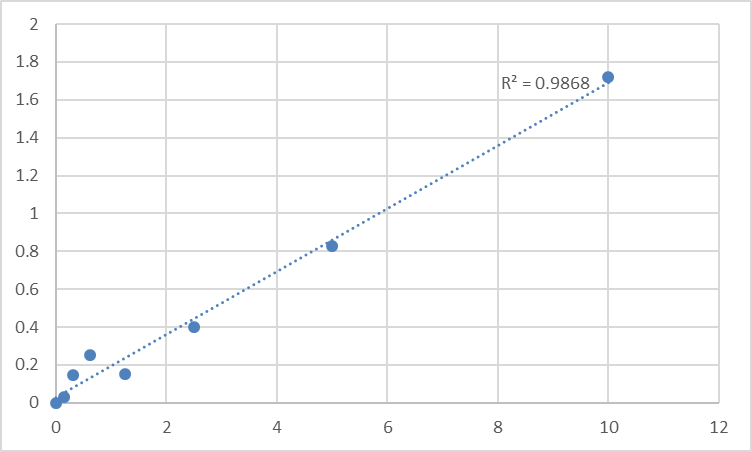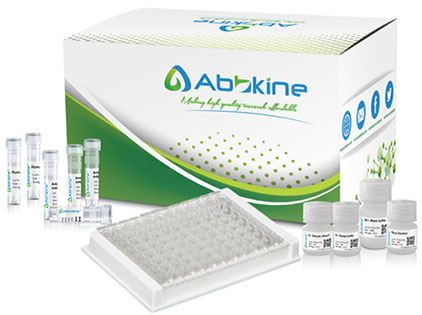| Product name | Human Dihydropteridine reductase (QDPR) ELISA Kit |
| Reactivity | Human |
| Applications | ELISA |
| Applications notes | This Human Dihydropteridine reductase (QDPR) ELISA Kit employs a two-site sandwich ELISA to quantitate QDPR in samples. An antibody specific for QDPR has been pre-coated onto a microplate. Standards and samples are pipetted into the wells and anyQDPR present is bound by the immobilized antibody. After removing any unbound substances, a biotin-conjugated antibody specific for QDPR is added to the wells. After washing, Streptavidin conjugated Horseradish Peroxidase (HRP) is added to the wells. Following a wash to remove any unbound avidin-enzyme reagent, a substrate solution is added to the wells and color develops in proportion to the amount of QDPR bound in the initial step. The color development is stopped and the intensity of the color is measured. |
| Detection method | Colorimetric |
| SampleType | Cell culture supernatants, Other biological fluids, Plasma, Serum |
| Assay type | Sandwich ELISA (quantitative) |
| Assay duration | Multiple steps standard sandwich ELISA assay with a working time of 3-5 hours. It depends on the experience of the operation person. |
| Alternative | QDPR; DHPR; FLJ42391; PKU2; SDR33C1; 6;7-dihydropteridine reductase; short chain dehydrogenase/reductase family 33C; member 1 |
| Kit components | • Human Dihydropteridine reductase microplate • Human Dihydropteridine reductase standard • Human Dihydropteridine reductase detect antibody • Streptavidin-HRP • Standard diluent • Assay buffer • HRP substrate • Stop solution • Wash buffer • Plate covers |
| Features & Benefits | Human Dihydropteridine reductase (QDPR) ELISA Kit has high sensitivity and excellent specificity for detection of Human QDPR. No significant cross-reactivity or interference between Human QDPR and analogues was observed. |
| Calibration range | Please inquire |
| Limit of detection | Please inquire |
| Usage notes | • Do not mix components from different kit lots or use reagents beyond the kit expiration date. • Allow all reagents to warm to room temperature for at least 30 minutes before opening. • Pre-rinse the pipet tip with reagent, use fresh pipet tips for each sample, standard and reagent to avoid contamination. • Unused wells must be kept desiccated at 4 °C in the sealed bag provided. • Mix Thoroughly is very important for the result. It is recommended using low frequency oscillator or slight hand shaking every 10 minutes. • It is recommended that all samples and standards be assayed in duplicate or triplicate. |
| Storage instructions | The unopened kit should be stored at 2 - 8°C. After opening, please store refer to protocols. |
| Shipping | Gel pack with blue ice. |
| Precautions | The product listed herein is for research use only and is not intended for use in human or clinical diagnosis. Suggested applications of our products are not recommendations to use our products in violation of any patent or as a license. We cannot be responsible for patent infringements or other violations that may occur with the use of this product. |
| Background | QDPR (quinoid dihydropteridine reductase) is part of the pathway that recycles a substance called tetrahydrobiopterin, also known as BH4. Tetrahydrobiopterin works with an enzyme called phenylalanine hydroxylase to process a substance called phenylalanine. Phenylalanine is an amino acid (a building block of proteins) that is obtained through the diet; it is found in all proteins and in some artificial sweeteners. When tetrahydrobiopterin interacts with phenylalanine hydroxylase, tetrahydrobiopterin is altered and must be recycled to a usable form. The regeneration of this substance is critical for the proper processing of several other amino acids in the body. Tetrahydrobiopterin also helps produce certain chemicals in the brain called neurotransmitters, which transmit signals between nerve cells. |
| Gene ID | 5860 |
| Alternative | QDPR; DHPR; FLJ42391; PKU2; SDR33C1; 6;7-dihydropteridine reductase; short chain dehydrogenase/reductase family 33C; member 1 |
| Accession | P09417 |

Fig.1. Human Dihydropteridine reductase (QDPR) Standard Curve.

Fig.2. Abbkine ELISA kit is series of sandwich ELISA to quantitate specific protein in samples.
You must be logged in to post a review.
Reviews
There are no reviews yet.